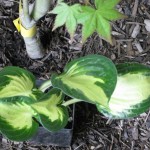A good general knows when and how to turn the tide of battle in his favor.
Armed with the recipe for a DIY insecticidal soap, I resolved to reverse my fortune on the garden battlefield and take action against the whiteflies destroying the coleus and the young hosta. I had a leftover 5 gallon plastic jug used to store raw garlic. I then combined 4 cups of water and 2 tablespoons of generic brand lemon-scented liquid dishwashing soap in said container and began shaking. Once it reached a frothy consistency, I grabbed a used Febreze spray bottle which had been doubling as my seedling spritzer, emptied it, and poured my secret weapon into it. Into the cool morning I marched and started spritzing the ravaged coleus. It seems that only 2 of the survivors were hardly affected, perhaps because of their longer exposure to sunlight. But they received the full bath, as well as the 2 Gold Standard Hostas that had been sitting in the bed. The hosta in the back (again, one that does not receive any sunlight) had been targeted mercilessly, having lost most of its new leaves to the attackers.
I surveyed the lawn to see if my previous day’s efforts had taken root. I had tackled the issue of the raggedy, browning lawn and turned loose the broadcast spreader. With a bag of Scott’s Turf Builder Bermudagrass Seed, I overseeded the front and courtyards with seed, in an effort to eradicate the patches. I realize that my efforts might be hampered to the amount of dead and tall grass, plus any hard soil that had not been previously raked. But I was resolved to get the task done and perhaps reseed at a later date in May to patch any remaining holes in the lawn. Let’s see if that 85% germination rate claimed on the label comes true!


















